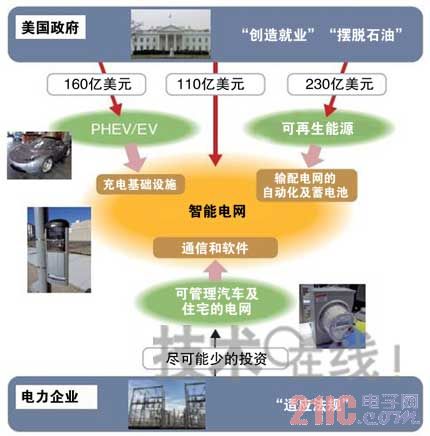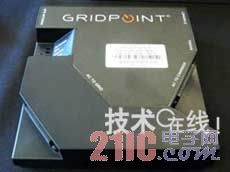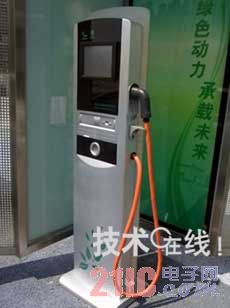4 trillion yuan!
This article refers to the address: http://
This is the total amount of funds that China plans to invest in the power infrastructure sector in the next 10 years. It is far from what others can do. For this huge investment plan, companies all over the world feel passionate. Nowadays, at the international standardization meeting of the charging infrastructure or the next-generation power grid "smart grid", "everyone has a Chinese speaking speaker, everyone will listen attentively" (Japanese people participating in the charging infrastructure standardization activities)
It is the United States that has high-level contacts with China that has announced huge investments. In November 2009, US President Barack Obama and Chinese President Hu Jintao jointly announced the "US-China Electric Vehicles Initiative" (China-US Electric Vehicle Initiative). In the future, the two parties will jointly develop and develop performance indicators for charging infrastructure and conduct empirical experiments in more than 10 cities. Although the two countries claim to be “common†on the surface, the United States already has a standardized framework related to smart grids, including the charging infrastructure component. George Arnold of the National Institute of Standards and Technology (NIST), which leads the standardization work in the United States, said that when dealing with China, "of course it will be based on this framework."
Japan is not far behind and has begun to challenge the Chinese market. Japan is taking business as its core. For example, Nissan announced in April 2009 that it will cooperate with China's Ministry of Industry and Information Technology to launch a charging infrastructure project in Wuhan. On November 14, the same year, the company said that it would start the same cooperation project with Wuhan in Guangdong Province.
In March 2010, five Japanese companies, including Nissan, led the establishment of “CHAdeMOâ€. The organization is primarily focused on the standardization of charging infrastructure. Among the automakers, Toyota, Fuji Heavy Industries and Mitsubishi Motors are also joining. Its characteristics are that its members also include Tokyo Electric Power, Japan's largest power company. In China, the leading charging infrastructure is standardized for power companies. Specifically, it is China's largest state-owned power company, State Grid Corp. “Tokyo Electric Power has provided transmission technology to the State Grid in the past, and it is closely related†(Japan Overseas Electronics Survey). In order to make full use of this relationship, Tokyo Electric Power served as a window for CHAdeMO's negotiation.
For the Japanese power company, which is based on the power business in Japan, the charging infrastructure involved in other countries did not have much benefit. However, Tokyo Electric Power has been developing fast charging stations to provide automotive manufacturers with performance indicators that can be easily used in the Japanese power grid. It is estimated that the purpose is to be consistent with the pace of Japanese automakers.

Figure: Japan and the United States aim at the Chinese market (click to enlarge)
China’s goal is to “take advantage of Japan’s beautyâ€
So, what kind of blueprint is China portraying itself as the core of its interests? The Shanghai World Expo, which opened on May 1, 2010, shows China's goal in charging infrastructure. National Grid used the Expo site as a place to experiment with smart grids including charging infrastructure. It can be seen from this experiment that it is characterized by the goal of taking the beauty of Japan and the United States.
In terms of the advantages of Japan, the National Grid aims to reduce the stability of grid reliability such as power outages, and intends to use it as the basis of the Chinese version of the smart grid concept. To this end, the State Grid has set up a system at the World Expo to automatically switch to other grid lines when a fault such as a broken line is detected. Like the Japanese power grid, the detection of disconnected wires and the communication of control signals use fiber-optic lines. The reason is that "although the cost is slightly higher than wireless communication, stable communication quality can be achieved" (State Grid).
The part that follows the example of the United States is the active use of EVs and smart meters. To this end, the State Grid has set up dozens of smart meters in the main facilities of the Expo site while publicizing the “Vehicle to Grid (V2G)†technology that can exchange power between the EV and the grid.
This time, the State Grid actually demonstrated a fast charging stand that supports V2G. When the EV is connected to the quick charging stand, it can be automatically switched between discharging and charging according to the supply and demand of the power grid. When the output of a solar cell or the like drops sharply, "an accident such as a power outage can be reduced by supplying power to the grid from tens to hundreds of EVs" (State Grid). When connected, the battery level and current can be confirmed by the display of the charging stand. The communication interface of the EV and the quick charging stand uses the in-vehicle LAN standard "CAN (Controller Area Network)". The fast charging stand supports DC power and the output power is up to 30kW. The voltage is 200-350V, and the current is 0-100A. The State Grid has not announced the time for practical use, saying only that "it will ultimately depend on the popularity of EVs."

Figure: State Grid actual demonstration V2G technology
The State Grid has prototyped two fast charging cradles that support V2G. One is located at the Shanghai World Expo venue and the other is located in the charging station of the Shanghai Caobao Road area. In addition to the quick charging stand, there are 11 ordinary charging stands in the charging station in the Caobao area. According to reports, the company has trial-produced 30 ordinary charging docks.

Figure: The State Grid developed a V2G-enabled fast charging station power operator to master the charging seat
In order to achieve V2G, in addition to the charging stand, the vehicle must be able to charge and discharge. This time, Shanghai Automotive (SAIC) and State Grid jointly developed an EV that supports V2G and demonstrated it. It is equipped with a lithium-ion rechargeable battery with a battery capacity of 35kWh, which can travel 310km once. Shanghai Automotive said that the company and the national grid "to work together to develop."
In addition to V2G, the rapid charging station developed by the State Grid has another important goal: the management of EV charging and discharging by the national grid rather than the car manufacturer. Specifically, it is a command to charge the EV to the EV. From the perspective of Japanese companies, Tokyo Electric Power and Nissan and other fast-charging stations that aim at global standards are orders that can be charged by vehicles, that is, automakers have the dominant power. The fast charging station of the State Grid is completely opposite.
It seems that China’s affairs have not developed in the direction envisioned by Japan and the United States. (Reporter: Shimizu Naoki)
Fast speed, simple and fast connection, no need for external power supply, good compatibility
Dongguan Bofan technology Co., LTD , https://www.ufriendcc.com